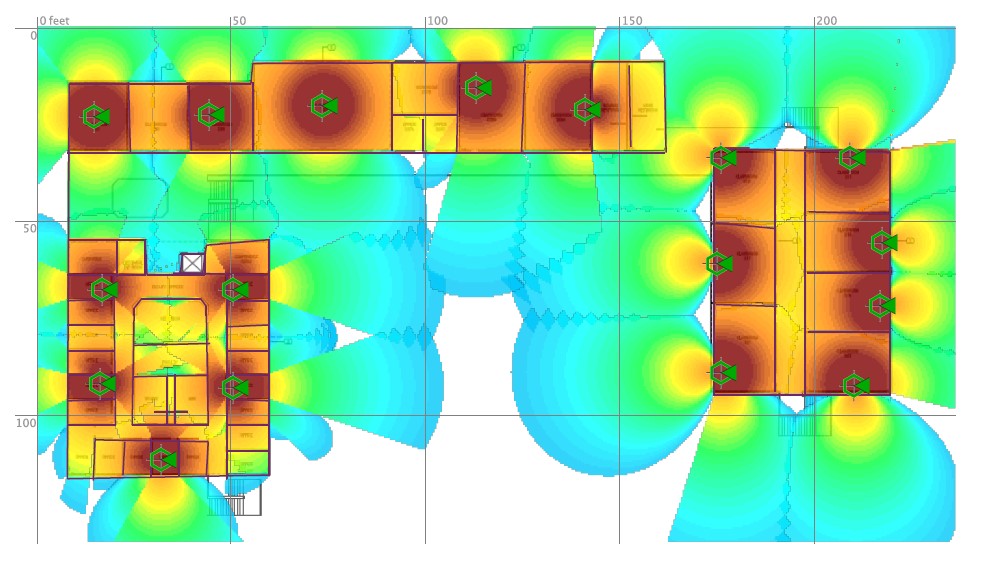By Rob Michaelis, Account Executive & Ahmer Bhatty, Network Engineer
Dasher Technologies partnered with two Silicon Valley city and community college campuses to refresh their aging networking infrastructures. The project has many facets including security, wired and wireless networking. In this mini case study, we focus on the wireless networking portion of the project to highlight some of its interesting aspects and how Dasher assisted to deliver next generation wireless capabilities to the faculty, staff and students.
![]()
As a trusted partner of the two colleges, Dasher was asked to review the current offerings in the marketplace for wireless solutions. Over several meetings, we gathered the business and technical requirements from various departments within the colleges.
The environment was made up of three locations. One location is the district office, which is a multi-story building. The other two locations are campuses with over 10 buildings each that require comprehensive wireless coverage. Dasher performed a wireless assessment to ensure that there would be adequate coverage and bandwidth to ensure a great end user experience. We produced an assessment report that showed a heat map of each building including outdoor spaces that need coverage, where each AP would be placed, and how it would be wired to the main campus network. Below is an example of one of the heat maps we created for the project.


Here is a link to a sample wireless statement of work and assessment report to demonstrate the types of reports we create.
The final solution consists of:
- 1000’s of wireless AP units that will eventually be installed and old AP’s to be removed
- AP’s supporting both wireless frequencies of 2.4GHz and 5GHz, with a focus to support the growing number of 5GHz users
- Devices that support both 802.11n and 802.11ac protocols
- The core wired network was designed to support the large number of AP’s by implementing core switches that can support 10GbE and 40GbE connections to different buildings based on the number of AP’s and traffic expected from each building or “edge of the network”
- The design was created to support 100G in the future
![]()
The project was scoped, a Dasher project manager was assigned to help define the timeline, and resources and dependencies were allotted to organize the project plan. As a result, we planned a multi-year project with delivery phases linked to the school’s instructional schedule and dependencies with the fiber infrastructure installation.
Cut-overs from the old to the new network are completed building by building, only taking one building out for service for a minimal amount of time, depending on the building size.
In order to shorten implementation time, we used the cloud management suite of the AP vendor to push the configurations to the APs when they are installed.
Along the way we learned that if the network infrastructure is to be replaced, it is more cost effective to replace the APs at the same time. We refined our approach to implementation to be less disruptive to the campuses by replacing the the APs as the wired network is upgraded.
The district’s main goal for the wireless portion of the project is to give students an excellent user experience no matter where they are on the campuses. Each campus had unique challenges based on their current wireless environment. In one case during phase 1, we replaced aging AP hardware with a plan to expand additional AP’s in the future. In another case, we augmented the existing environment and left current AP’s in place with a plan to remove the pre-existing AP’s as they age out.
![]()
The IT staff at the college is made up of five members. Throughout the entire project, we worked alongside their team to educate them on their products and solutions. We trained the staff members on how to use the management tools to troubleshoot eventual wireless issues that may arise as the campus comes online. We also provided training credits so the IT staff can take formal training from our vendor partners.
![]() The multi-year plan calls for Dasher to perform bi-annual checkups with the college to ensure the system is at optimal performance.
The multi-year plan calls for Dasher to perform bi-annual checkups with the college to ensure the system is at optimal performance.
![]() District Office is 100% Complete
District Office is 100% Complete
One Camus is 90% Complete
2nd Campus is 10% Complete
The deployment is 80% completed and each of the new buildings brought online are running as expected.
For more information on some of Dasher’s newest networking partners follow the link.
If you are interested in security solutions, please read here.

